Growing up in Colorado, Jason Persoff had lots of opportunities to enjoy all the adventures Mother Nature created. As a child, he was fascinated by the severe weather that resulted in amazing cloudscapes of thunderstorms.
“The lights, the colors, the drama all appealed to me from an early age,” says Jason, who today is a medical doctor in Aurora, CO. “I got my first camera when I was eight, and immediately wanted to take pictures of the skies, and figure out how to frame the photos in a way that gave people perspective about size and grandeur. But I was eight, and it was a Polaroid camera, so I wasn’t particularly successful. I understood what I wanted it to do, though.”
He recalls getting excited when severe weather would loom in the spring and then being very sad as it would move away. “It wasn’t until college when I read about storm chasers in USA Today that I realized instead of getting sad as the weather moved away, I could actually FOLLOW it,” Jason recalls. That changed his entire perspective, and he set out to photograph storms and chase them to boot.
On his website, he shares: “I am a storm-chasing physician based out of Aurora, Colorado, and am a very blessed husband and father to three amazing children. I have been chasing storms for over two decades, but a lifelong lover of storms.”
The storm photography is stunning, but there is another element to Jason’s creativity that captures the essence of wintertime: Photographing snowflakes.

Snowflake photographer and storm chaser Jason Persoff – this time in front of the camera instead of behind. Photo: Jason Persoff
Some of the links in this article may contain affiliate links. When you purchase using these links, part of the proceeds go to Snowshoe Mag. Additionally, as Amazon Associates, we earn from qualifying purchases. Please see our disclosure for more details.
Capturing snowflakes on camera
Photographing a single snowflake is no easy task. But with 62 inches (157.5 cm) of annual snowfall right outside his doorstep, Jason gets a lot of opportunities.
The truth about snowflakes
He explains the process of his snowflake photography“Snowflakes are amazing in that they tell a story as they fall through the atmosphere. The really beautiful flakes I take pictures of are called stellar dendrites. These types of flakes have spectacular structures and only form in very particular conditions. Most snow is not beautiful, usually just little fragments of ice. But stellar dendrites are beautiful and usually only form during really cold weather (10 to 25 °F/ -12 to -6 °C) and only in certain humidities and pressures. Each flake takes about 30-60 minutes to form as it falls from the sky. The really cool thing is that each flake starts as water vapor that freezes into a particle of dust. That dust comes from volcanoes, windstorms, [and] even small aerosolized bacteria can be the starting point of the developing snowflake.
It’s true that no two snowflakes are alike. Even across the span of a single 1-2mm snowflake, there are differences in the microclimates resulting in snowflakes not even having perfect symmetry. Many of my photos show that even two branches of a single snowflake will grow differently – and that’s a difference in climate of often nanometers! They are literally so cool!”
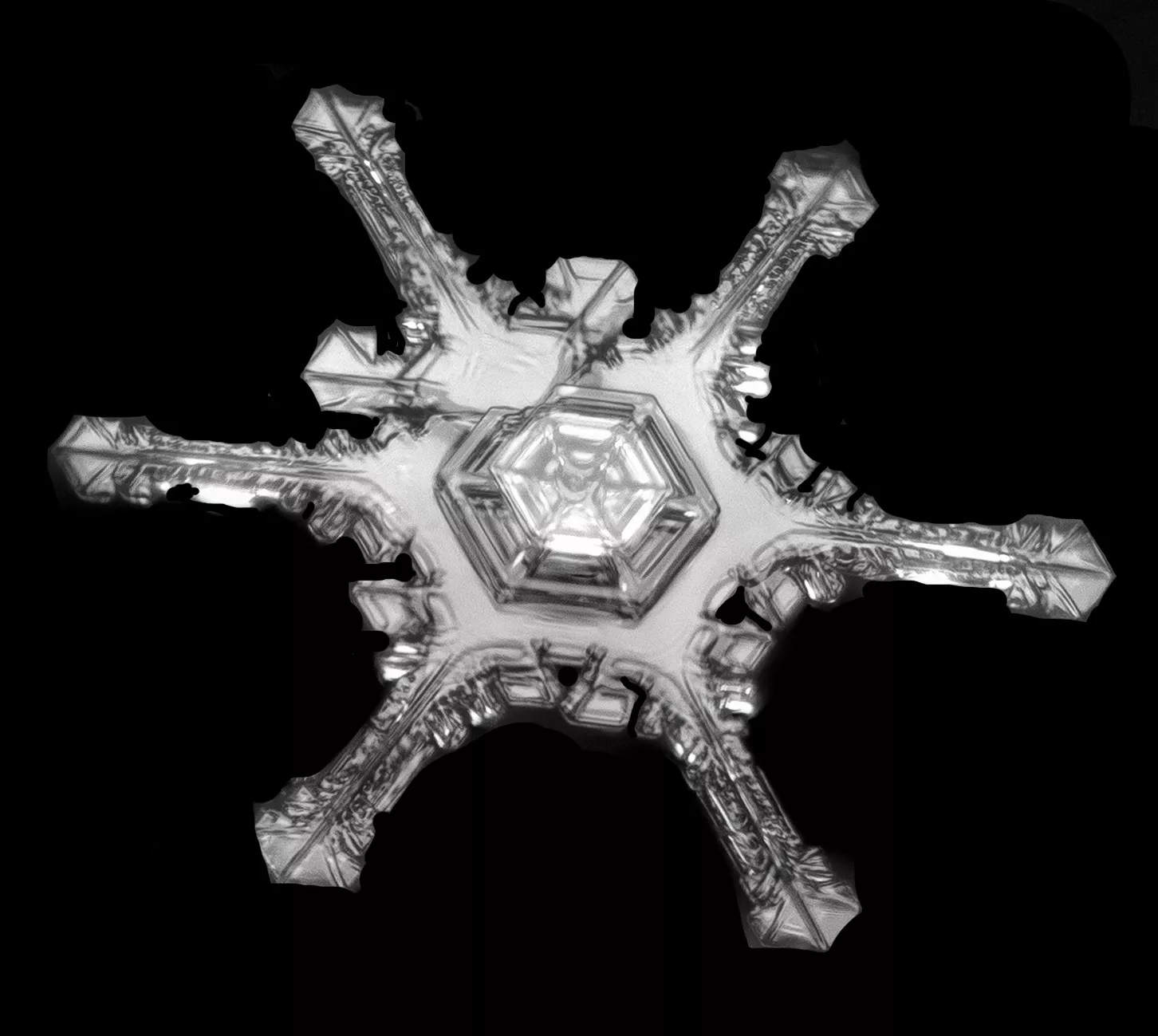
No two snowflakes are alike, and even two branches can grow to be of different sizes. Photo: Jason Persoff
How to capture a snowflake
Learning about snowflakes and how to capture them on film was nothing more than a serendipitous discovery. “I came across Canadian Don Komarechka while flipping through photography groups when I saw one of his snowflake photos,” recalls Jason. “My initial impression was, ‘This cannot be how snowflakes actually look.’ Most snowflake photography is done by shooting a snowflake on a slide, like a microscope slide, with the light traveling through the snowflake into the lens – a beautiful transparent snowflake. But Don showed what happens when you flip the lighting to be from above the snowflake. Suddenly, these ice crystals had peaks and valleys, remarkable 3D landscapes. I was enthralled and committed to learn how to do what he was doing. Don was exceptional and offered guidance and tutelage, and then I began to develop my own technique. I continue to refine those skills even to this date.”
Read More: Winter Photography Tips for Snowshoers
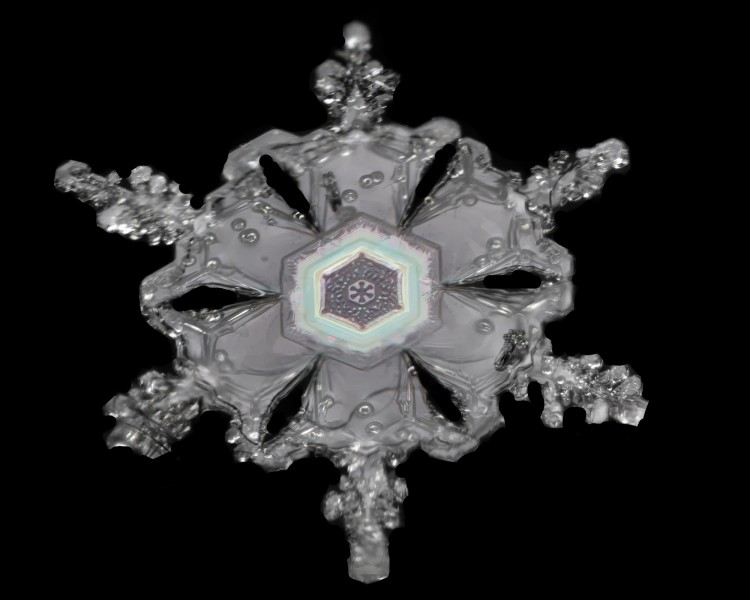
Snowflakes are filled with peaks, valleys, and colors when the lighting is above a snowflake. Photo: Jason Persoff
No special equipment required
Surprisingly, Jason doesn’t use any special or elaborately expensive equipment to produce his incredible snowflake photos. “I shoot with a Sony A7iii,” he says, “but the lens setup is pretty budget: A Canon EFS-60mm lens on top of two sets of extension tubes. The whole thing is topped off with a ring flash, which is also budget.”
When it snows, Jason doesn’t just run outside and point the camera skyward, hoping to capture a falling snowflake. Rather, he uses a very strategic process, somewhat budget as well. He grabs a black sock and holds it out to capture snowflakes. Given that dramatic contrast, he then quickly starts photographing snowflakes before they disappear. Recently, he captured a 12-sided snowflake; most snowflakes are only six-sided.
Jason offers this brief explanation: “Those 12-pointed snowflakes are rare because they require a chance meeting. Since water can only make crystals with angles of 60 degrees, a 12-sided snowflake is theoretically impossible. What takes place early on in the snowflake’s genesis is that two snowflakes become adhered together. Then, as they tumble through the clouds, they encounter identical atmospheric conditions leading to the arms of each flake forming the way you see in the photo”.
Read More: Beginner Outdoor Photo Tips: Make Memories on the Trail
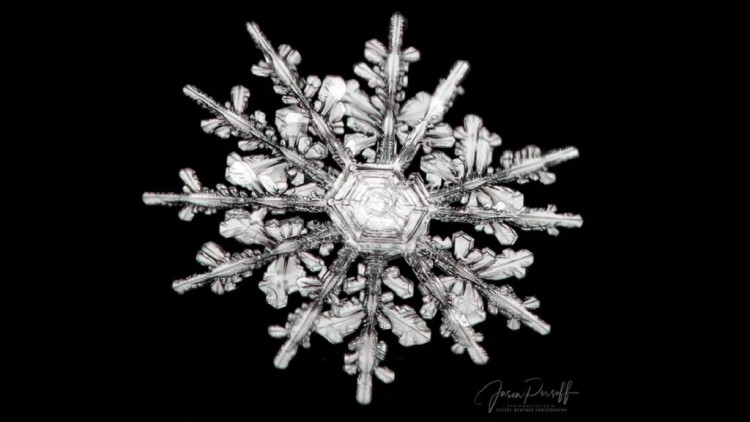
The rare 12-sided snowflake occurs when two snowflakes become adhered together. Photo: Jason Persoff
Funny man
In addition to his many talents, Jason is also a self-proclaimed stand-up comedian. Here is a sample of his humor: “I always practice a catch-and-release philosophy with the snowflakes. So, none are harmed in the process, to the best of my knowledge.”
A note from Jason about Jason: “In my spare time, I enjoy working as a professional and internationally renowned storm chaser; I’m also fluent in American Sign Language, competitive fencing, and a stand-up comedian.” And that’s no joke!
For those interested in learning more about Jason’s talents as a snowflake photographer, visit Jason’s YouTube Channel. In nine short videos, he explains how to photograph and process snowflake photos. This is clearly Jason’s version of paying it forward, like his mentor Don Komarechka did a number of years ago.
In case readers are assuming that Jason Persoff is a big-time snowshoer, think again. He has snowshoes, and he’s been snowshoeing. It’s just not a priority right now. But then again, this doctor, storm chaser, and snowflake photographer have three good excuses!
A final thought from the Storm Chasing doc: “It’s easy to get caught up in goals or the hustle and bustle of daily life. I hope my photography helps people slow down and admire the amazing sights around us every day; that they pause and consider how many beautiful things there are in the world if we only stop to pay attention.”
Read Next: The Snow Artist Simon Beck: The Art of Snowshoeing, Snowshoeing as Art

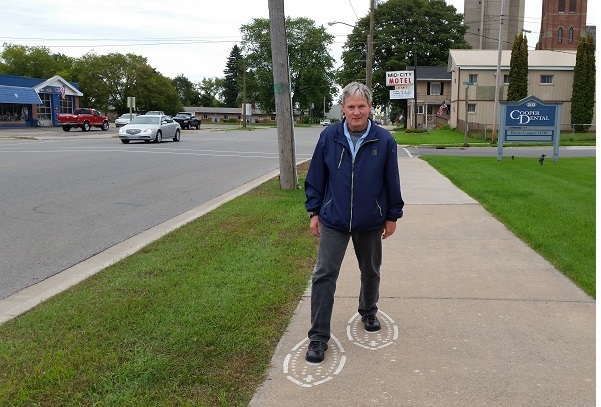
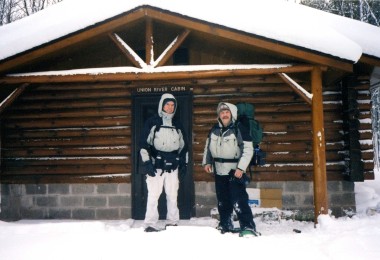
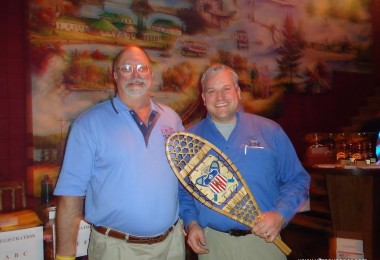
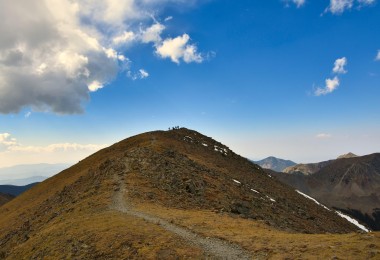
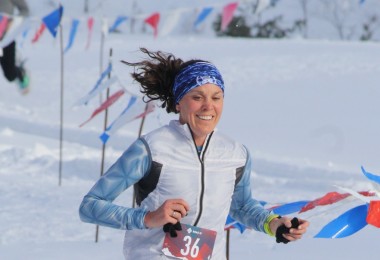

Fascinating. I loved the photographs and learning about snowflakes was a bonus.